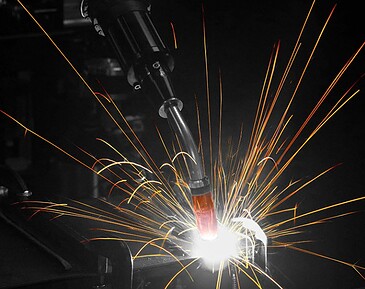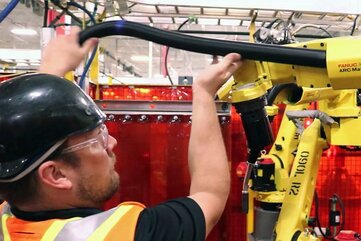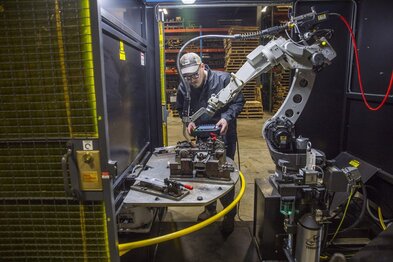Understanding the Impact of Time Sinks in Robotic Welding
Estimated reading time: 7 minutes
No robotic welding cell operates at 100% capacity. Parts handling, fixturing, periodic rework and even employee breaks all affect a robot’s ability to be completely efficient. However, there are common time sinks that can further hinder productivity — and they can easily lead to increased costs and lower quality.
Time sinks are activities that consume a lot of time for little benefit. So why do these happen? It could be a lack of training or lack of skilled labor. Or it could be simply out of habit; some activities may fall into the “we’ve always done it this way” category.

The key is to take steps to rectify these issues quickly, as they can easily escalate. That is especially true on large production lines. If one robot has an issue, it may result in having to stop an entire line of robots to solve the problem, compounding downtime.
Streamlining the process
Downtime for certain activities in a robotic weld cell is unavoidable, but they become time sinks when they aren’t streamlined. Welding contact tip changeover is a prime example.
While regular changeover is imperative to producing quality parts, it is not uncommon for operators to replace a contact tip before it is necessary. It can become a habit to change the tip every few hours, during breaks and before and after shifts without truly knowing whether there is still life left in the consumable. This frequency interrupts production, resulting in fewer parts being made and increased costs for the tip itself.
Conducting a time study to determine the true life of a contact tip — from installation to the point of failure — can help companies avoid excessive changeover and costs. The study may be time-consuming initially, but it can be conducted in one robotic welding cell to establish a baseline and then applied to similar cells.

It’s also recommended to try different types of contact tips to ensure that the best option is in place. For example, pulsed MIG welding applications are especially harsh on tips, so it’s essential to have an option for that waveform, like the AccuLock™ HDP contact tips, to extend product life. There is a higher upfront cost for these tips, but also a significant increase in productivity and throughput due to significantly less-frequent changeover.
Reaming too often can also become a time sink in a robotic welding cell. A nozzle cleaning station (or welding reamer) is necessary to clear spatter from the front-end welding consumables and ensure smooth gas flow, but it’s important to determine the optimal frequency for the application. For example, if a robot completes a 2-inch weld and then spends 10 seconds to ream, spray anti-spatter, nozzle-check and wire-cut, that is likely too often. Instead, it may be possible to weld 10 to 20 parts between reaming cycles. Again, a time study can help determine the appropriate frequency.
Common time sinks and tips for avoiding them
True time sinks may not be immediately obvious and the activities themselves may appear benign, but they can have consequences that result in extra time, labor and costs for welding troubleshooting. Fortunately, there are options to rectify these issues.

1. Poor wire conduit management
Due to the high volume of parts that pass through a robotic welding cell, most companies employ large welding wire drums to minimize changeover of these packages. Poor management of the conduit leading from the drum to the robot can lead to time sinks. If this conduit is too long, has been placed around the corner or snakes and bends along the floor, the wire won’t feed properly. Poor wire feeding can lead to burnbacks that require downtime for welding contact tip changeover. It can also cause the arc to become erratic, which causes quality issues and potential rework. The best way to resolve this issue is to keep the conduit as straight as possible and use the shortest run feasible.
2. Incorrect robot positioning and neck selection
Many large companies, such as tier-one automotive suppliers, measure their efficiency based on available square footage, so placing many robots in an area is common. This helps meet high production goals. However, if a company positions the robot incorrectly in relation to the tooling, it can increase robot articulation and lead to premature cable failure. The same holds true when using the wrong robotic MIG gun neck. While companies often like to standardize on one neck angle throughout the operation, it may not allow the robot to articulate properly to reach the weld joint.
As a best practice, the robot riser should be sized to minimize the amount of joint articulation when accessing the tooling. This reduces stress on the robotic MIG gun and the power cable. Select the appropriate neck angle to achieve the best joint access.

3. Troubleshooting on the line
When something goes wrong in a robotic welding operation, often the first instinct is to try to troubleshoot the issue on the spot. Doing so yields little benefit since it stops production: not just because the robot isn’t working, but also because multiple personnel may be stepping away from their jobs to address the problem. That adds up to unnecessary time and money spent.
A better option is to remove and replace the component causing the trouble, whether it be the robotic MIG gun or a welding reamer. That allows the robot to go back to work producing parts, while maintenance troubleshoots and repairs the equipment issue offline.
4. Overlooking preventive maintenance (PM)
Like troubleshooting on the line, reactive maintenance can be a significant time sink. Addressing unexpected problems keeps the robot from its job of producing parts. Also if something goes wrong within the weld cell because PM wasn’t performed, it can lead to poor quality parts, rework or costly repairs.
Instead, welding supervisors and operators should schedule time to perform preventive maintenance, such as checking connections and visually inspecting consumables for spatter during routine pauses in welding. More time-consuming PM activities, like replacing a gun liner, a robotic MIG gun or cable, or cleaning the robot, can happen between shifts or during other planned downtime.
Making a difference
When there are jobs to be done, it’s easy for companies to focus on moving production along and sending parts out the door. In the process, time sinks can occur that may be overlooked for long periods of time, compounding their severity.
However, pausing to look at the robotic welding operation and setting plans in place can help create efficiencies in the long run. In addition to time studies, conducting a process failure mode analysis (PFMA) can help by considering anything that could go wrong in the robotic welding cell. These situations are then ranked by potential frequency and severity and a plan put in place for addressing them.
It’s also important to remember that changes and improvements aren’t one-time occurrences. They must be monitored regularly and adjusted as needed. Coordinating a continuous improvement team to spearhead the process can help, as can working with a trusted welding equipment or robot manufacturer.